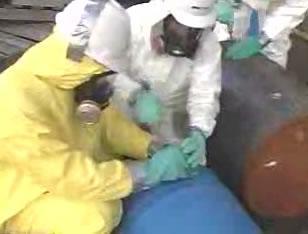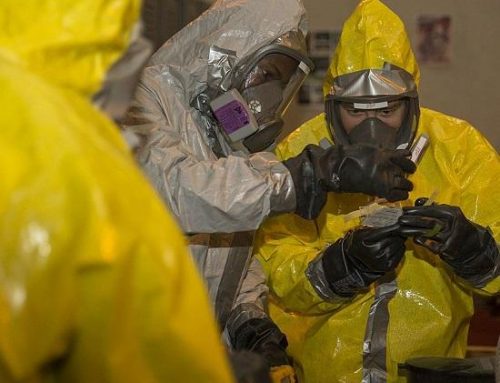Understanding chemical hazards is an important part of a successful Hazardous Waste Operations and Emergency Response (HAZWOPER) program. Chemical hazards are substances that have the potential to cause harm to humans or the environment. In this article, we’ll provide an overview of chemical hazards and offer some helpful tips for businesses looking to understand and manage them.
What are Chemical Hazards?
Chemical hazards are substances that have the potential to cause harm to humans or the environment. Chemical hazards can be found in many forms, including liquids, gases, solids, and vapors, and can be toxic, flammable, corrosive, or reactive.
Chemical hazards can be classified according to the potential harm they can cause. For example, some chemicals may be classified as carcinogens, which are substances that have the potential to cause cancer. Other chemicals may be classified as reproductive toxins, which are substances that have the potential to harm the reproductive system.
Why is Understanding Chemical Hazards Important?
Understanding chemical hazards is important because it helps protect workers and the general public from potential harm. By understanding the properties and hazards of chemicals, businesses can take steps to properly handle and store them to minimize the risk of exposure.
In addition, understanding chemical hazards are often required by law or regulatory agencies, such as the Occupational Safety and Health Administration (OSHA), as a means of ensuring the safety of workers and the general public. By understanding chemical hazards, businesses can help ensure compliance with regulatory requirements.
Tips for Understanding Chemical Hazards
Here are 10 tips to help your business understand and manage chemical hazards:
- Conduct a hazard assessment: Conduct a hazard assessment to identify the chemical hazards present in your workplace and the potential risks associated with them.
- Gather information about the chemicals: Gather information about the properties and hazards of the chemicals in your workplace. This information can be found on the chemical’s safety data sheet (SDS).
- Classify the chemicals: Classify the chemicals according to the potential harm they can cause.
- Develop a chemical inventory: Develop a chemical inventory to keep track of the chemicals present in your workplace and their associated hazards.
Store chemicals properly: Proper storage is crucial to minimize the risk of exposure to chemical hazards. Follow established protocols for storing chemicals to ensure their safety. - Label chemicals correctly: Proper labeling is essential to help workers identify and understand the hazards associated with chemicals. Use the information provided on the SDS to label chemicals correctly.
- Use personal protective equipment (PPE): Use appropriate PPE when handling chemicals to minimize the risk of exposure.
- Follow established protocols for handling and using chemicals: Follow established protocols for handling and using chemicals to minimize the risk of exposure and accidents.
- Train employees on chemical hazards: Proper training is crucial to ensure that employees understand the hazards associated with chemicals and how to protect themselves.
- Regularly review and update chemical hazard information: Regularly review and update your chemical hazard information to ensure it is accurate and up-to-date.
Conclusion
Understanding chemical hazards is an important part of a successful HAZWOPER program. By following the tips outlined above, businesses can take steps to protect workers and the general public from potential harm. It’s worth noting that understanding chemical hazards is just one part of a successful HAZWOPER program. Other key elements include personal protective equipment, monitoring procedures and equipment, and emergency response planning. To ensure the safety of your workers and compliance with regulatory requirements, it’s important to have a well-rounded program that addresses all of these areas.
Do you need HAZWOPER Online Training?
Try a free demonstration of HAZWOPER: Understanding Chemical Hazards
Excerpt from the outline for HAZWOPER: Understanding Chemical Hazards
OUTLINE OF MAJOR PROGRAM POINTS
The following outline summarizes the major points of information presented in the program. The outline can be used to review the program before conducting a classroom session, as well as in preparing to lead a class discussion about the program.
You may have heard of hazard communication and “Right-To-Know” before, but you may not have thought about how it affects you.
— An ordinary cleanser can actually be toxic, flammable and explosive.
You have the “right-to-know” about potentially hazardous materials that may be encountered in your workplace.
— That is the reason for OSHA’s Hazard Communication Standard and similar state laws.
— The goal of these laws is to make sure that you have the information, training and equipment needed to work safely around hazardous materials.
Chemical hazard information is communicated to you in three different ways:
— Safety Data Sheets (SDS).
— Container labels.
— Your facility’s written “hazard communication program.”
The SDS is a guide for the safe use of a specific chemical.
— Chemical manufacturers and distributors provide an SDS for each of the products they sell.
— Your facility keeps copies of each SDS on file for reference.
The Safety Data Sheet is the primary source for information about a chemical product. The SDS lists:
— All of the names which the chemical is known by.
— The manufacturer.
— Any hazardous ingredients.
The SDS also describes:
— The types of hazards that the chemical may present.
— First aid procedures for chemical exposures.
— Techniques for cleaning up spills.
To help you work with the chemical safely, the SDS also contains information about:
— How to handle and store the chemical properly.
— What types of exposure controls and personal protective equipment (PPE) should be used for protection.
SDS’s can come in different formats, but they all contain the same information.
— Become familiar with the SDS before working with a potentially hazardous material.
— The few minutes this takes could prevent serious problems in an emergency.
Another place to look for “Right-To-Know” information is on a chemical’s container label. The label will provide:
— The material’s name and potential health, fire and reactivity hazards.
— Specific precautions to take, or situations to avoid, when working with the chemical.
— What PPE to wear when handling the chemical.
Like SDS’s, all labels do not present information in the same way. They can:
— Be written.
— Use shapes, numbers or letters as warnings.
— Use “symbols” or “pictures” to represent hazards or the required PPE.
Whichever labeling system that your facility uses, read the label carefully before working with any chemical.
— If a chemical is transferred to another container, make sure that the “secondary” container is also labeled properly.










